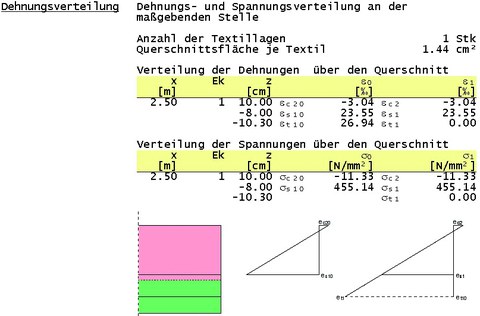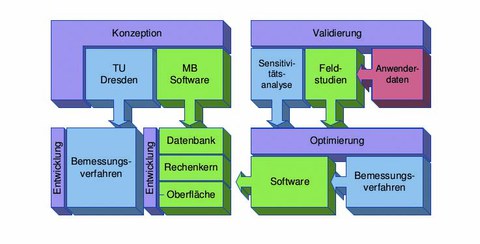Entwicklung einer Bemessungssoftware für Bauteilverstärkungen aus Textilbeton
Inhaltsverzeichnis
Projektdaten
| Titel | Title Entwicklung einer Bemessungssoftware für Bauteilverstärkungen aus Textilbeton | Development of a design software for strengthening structural components with TRC Förderer | Funding Bundesministerium für Wirtschaft und Energie (BMWi); Projektträger: AiF Projekt GmbH Zeitraum | Period 11.2012 – 04.2015 Leiter | Project Manager Prof. Dr.-Ing. habil. Ulrich Häußler-Combe Bearbeiter | Contributor Dipl.-Ing. Jörg Weselek Projektpartner | Project Partner mb AEC Software GmbH, Kaiserslautern |
Bericht aus dem Jahrbuch 2014
Softwaremodul Textilbeton – Bemessung leicht gemacht!

Spannungs- und Dehnungsverteilung im verstärkten Querschnitt
Textilbeton als neuer Werkstoff für Ertüchtigung und Instandsetzung wird kaum die allgemeine Anerkennung finden, wenn ein entsprechendes Hilfsmittel zur Bemessung von Bauteilverstärkungen fehlt. Hierzu entsteht bei der Firma mb AEC GmbH aus Kaiserlautern für die etablierte Softwaresammlung BauStatik® ein Modul speziell ausgelegt für den Einsatz in Ingenieurbüros des deutschsprachigen Raums. Ebenfalls von der AiF gefördert, steht das Institut für Massivbau der Technischen Universität als wissenschaftlicher Partner zur Seite.
Das Modul basiert hauptsächlich auf den umfangreichen Ergebnissen des DFG-Sonderforschungsbereichs SFB 528. Momentan kann die Betaversion des Moduls bereits zur Bemessung von Verstärkungen biegebeanspruchter Bauteile herangezogen werden. Dabei erfolgt die Berechnung nach Anlage 5 der „Allgemeinen bauaufsichtlichen Zulassung für ein Verfahren zur Verstärkung von Stahlbeton mit TUDALIT (textilbewehrter Beton)“, die im Sommer 2014 vom DIBt erteilt wurde. Für die Nachweisführung werden die traditionellen Verfahren zur Biegebemessung von Stahlbetonbauteilen verwendet und teilweise erweitert.
Durch die schrittweise Abarbeitung obligatorischer Angaben zum System und den Einwirkungen können Querschnitts- und Materialwerte definiert werden, woraufhin die Berechnung der notwendigen Verstärkungsschichten initiiert wird. Weiterhin wurde das interaktive Hilfesystem zur Vermittlung der Grundlagen zum Verstärken mittels Textilbeton angepasst und es gibt zudem nützliche Hinweise zum Bemessungsalgorithmus. Die grafische Ausgabe mittels Schnittgrößenverläufen oder Dehnungsverteilungen gehört ebenso dazu. Das Institut für Massivbau engagiert sich momentan bei der redaktionellen Bearbeitung der Angaben des Hilfesystems. Weiterhin sind Lastszenarien erstellt worden, die zum Testen des in der Firma entstandenen Rechenkerns herangezogen werden müssen, um die Ergebnisse des Bemessungsmoduls zu validieren. Dabei werden spezielle Szenarien berücksichtigt, die für den Nachweis im Grenzzustand der Tragfähigkeit zu Konvergenzproblemen führen könnten, da es sich bei dem Bemessungsverfahren um einen iterativen Algorithmus handelt. Solcherart Probleme dürfen natürlich zur Programmauslieferung nicht mehr vorhanden sein, weshalb die Wichtigkeit dieses Arbeitsschritts nicht unterschätzt werden darf.
Bericht aus dem Jahrbuch 2013
Der Sprung in die Praxis

Teilprojektsynergien der Projektpartner
Textilbeton ist in aller Munde. Doch wann kann von einer erfolgreichen Überführung der im Sonderforschungsbereich 528 gewonnenen Erfahrungen in die Praxis die Rede sein? Ein großer Schritt auf dem Weg in die Ingenieurbüros Deutschlands soll mittels der Kooperation mit einem etablierten mittelständigen Softwareunternehmen gelingen. Die Firma mb AEC Software GmbH in Kaiserslautern bietet insbesondere modularisierte Bemessungssoftware an, die die Implementierung der Bemessungsmethoden für Textilbetonverstärkungen unterschiedlicher Art ermöglicht.
Im Rahmen des Projekts werden die umfangreichen Forschungsergebnisse des SFB 528 in Korrespondenz mit dem Industriepartner gesammelt und vermittelt. Dabei werden die bei der Verstärkung von Bauteilen maßgebendsten Lastszenarien, wie Momenten-, Querkraft-, Normalkraft und Torsionsbeanspruchung, berücksichtigt. Neben der Implementierung der Bemessungsmodelle müssen außerdem die Materialwerte der Textilien und Betone in die bei mb AEC vorhandenen Werkstoff- und Bauteildatenbanken eingepflegt werden, wobei das Institut für Massivbau beratende Funktion übernimmt. Anschließend können Schnittstellen zur bereits vorhandenen Benutzeroberfläche programmiert werden. Des Weiteren sollen dem Anwender die theoretischen Grundlagen möglichst plausibel und anschaulich vermittelt werden, was die Erstellung eines entsprechend zugeschnittenen Hilfesystems erfordert. Mit diesem können die speziellen Eigenarten der Textilbetonbauweise und Anwendungsmöglichkeiten und -grenzen veranschaulicht werden.
Sind die theoretischen Modelle in Algorithmen gefasst, kann die Validierungsphase beginnen. In dieser besteht die Aufgabe des Instituts darin, anfangs eine Sensitivitätsanalyse durchzuführen, deren Ergebnis eine Bewertung der Abhängigkeiten zwischen den Ausgangsgrößen, meistens Grenzlasten, von den Eingangsgrößen zulässt. Dafür können die in den vergangenen Jahren gesammelten, umfangreichen Versuchsdaten verarbeitet werden. Die fertigen Softwaremodule werden für hundertfache Berechnungen verwendet, die sich durch eingeschickte Variation der Eingangsgrößen auszeichnen, woraufhin die Ausgangsgrößen statistisch ausgewertet werden und der Einfluss verschiedener Eingangsgrößen abgeleitet werden kann. Dadurch können das anzusetzende Sicherheitsniveau verbessert und letztendlich die Bemessungsverfahren in wirtschaftlicher und technologischer Hinsicht weiter optimiert werden, was letztendlich der Weiterentwicklung der Softwaremodule zu Gute kommt.
